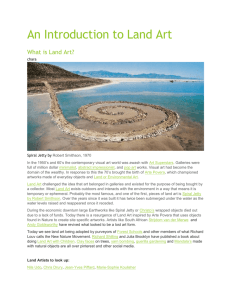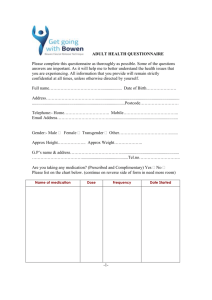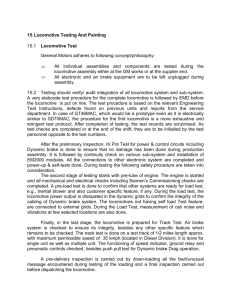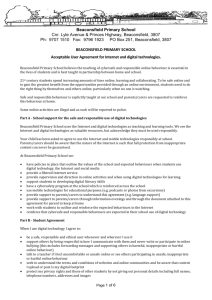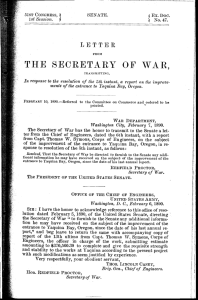THE WYETT TRAMWAY
advertisement
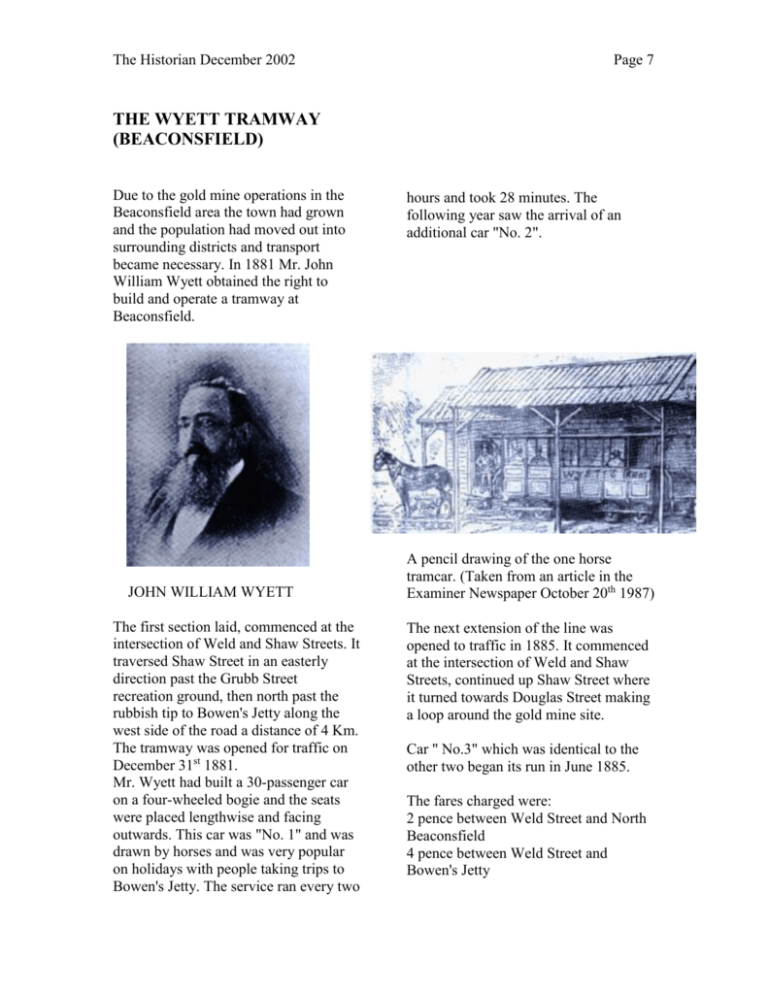
The Historian December 2002 Page 7 THE WYETT TRAMWAY (BEACONSFIELD) Due to the gold mine operations in the Beaconsfield area the town had grown and the population had moved out into surrounding districts and transport became necessary. In 1881 Mr. John William Wyett obtained the right to build and operate a tramway at Beaconsfield. JOHN WILLIAM WYETT The first section laid, commenced at the intersection of Weld and Shaw Streets. It traversed Shaw Street in an easterly direction past the Grubb Street recreation ground, then north past the rubbish tip to Bowen's Jetty along the west side of the road a distance of 4 Km. The tramway was opened for traffic on December 31st 1881. Mr. Wyett had built a 30-passenger car on a four-wheeled bogie and the seats were placed lengthwise and facing outwards. This car was "No. 1" and was drawn by horses and was very popular on holidays with people taking trips to Bowen's Jetty. The service ran every two hours and took 28 minutes. The following year saw the arrival of an additional car "No. 2". A pencil drawing of the one horse tramcar. (Taken from an article in the Examiner Newspaper October 20th 1987) The next extension of the line was opened to traffic in 1885. It commenced at the intersection of Weld and Shaw Streets, continued up Shaw Street where it turned towards Douglas Street making a loop around the gold mine site. Car " No.3" which was identical to the other two began its run in June 1885. The fares charged were: 2 pence between Weld Street and North Beaconsfield 4 pence between Weld Street and Bowen's Jetty The Historian December 2002 The stops were: Bowen's Jetty, Bowen's Jetty Road, North Beaconsfield, New Street, Ophir Street, Shaw Street and Weld Street. The final extension was opened in January 1886. This branch line left the main line to Bowen's Jetty and continued on to Beauty Point Wharf via a bridge over Pease Creek and ran beside what are now Kemp's Parade and the Port Dalrymple Yacht Club. In the latter part of 1890 another tramcar was added "No 7" and about a dozen bogie flat trucks were placed in service. In 1902 another locomotive was purchased, "No 3". In 1903 the Tasmania Gold Mining Company purchased the entire business from John Wyett for the goodly sum of 4,000 pounds. It consisted of, the tramway, 3 locomotives, 7 cars and 12 trucks. A larger depot was erected in Weld Street and additional sidings were provided at Bowen's Jetty and Beauty Point. After the closing of the Mine the service ceased to operate on the 25th of December 1915. With the opening of the Beauty Point line it was decided to employ steam power on the tramway. A Kerr Stuart 04-0 tank locomotive was purchased from Scotland and placed in service in January 1886 along with an additional tramcar. The tramcar was numbered "No 4" and the locomotive, "No 1". The steel rails of the track had a gauge of 30 inches (762mm.) (Right) This locomotive a 0-4-0 tank was brought into service in January 1886. In the picture are Driver, George Glover, Fireman, Hugh Shean, and Guard, Barney Watson. This service proved to be so satisfactory that it was decided to convert the horse drawn cars Nos.1to 3 into steam trailers. The new arrangements provided a steam service to Bowen's Jetty and a local horse service from Weld Street to Beauty Point In 1889 a second locomotive" No 2" was purchased along with two more tramcars "No 5" and "No 6". With these arrivals steam trams replaced the horse cars on the Beauty Point line. Relics of the Kerr Stuart locos are still in existence. One was used to power a sawmill in the Camden district near Mt. Barrow. During the early 90's Keith Joyce and others from the Grubb Shaft Museum found the bogie of this unit close to the old mill site. A driver's cab is owned locally The museum have some components. Plans to build one of the now extinct engines was abandoned due to the estimated cost at the time, however such a project would still be possible. In 1890, Mr. Wyett made an agreement with the Tasmania Gold and Quartz Crushing Company to haul a number of company bogie flat cars to move materials from the Beauty Point port to Beaconsfield. Some 20 years ago the late Doug McLachlan of Exeter built a quarterscale, fully operational model of a Kerr Stuart 0-4-0 locomotive, complete with fuel tender, passenger cars and signaling equipment plus 180m of 7.5 inch Page 9 (190.5mm) gauge steel track, arranged in a circuit through his orchard. A ride, sitting astride the little passenger car, whizzing past the apricot trees was an unforgettable experience. The complete model is now owned by the West Tamar Council's Grubb Shaft Museum and is in the process of being reconditioned, hopefully soon to be in running order as a major tourist attraction. The Historian December 2002 Page 10 Compiled by Richard Hooper and Helen Phillips from information supplied by Mrs. Doll Kalliski from the book by Thomas C.T. Cooley "Railroading in Tasmania I would also like to thank the staff at the Beaconsfield Gold and Heritage Museum for providing some of the information and photos.



